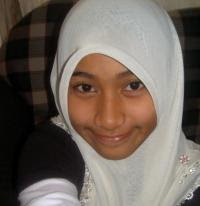~abah pesan study leklok
~abah pesan surowh jd cm dy
~abah pesan kat aku suroh hormat orng tua
~abah pesan kat aku surowh jd ank yg solehah
~abah pesan kat aku jd orng yang baek
~abah pesan kat aku spya jd orng yg x degil
~abah pesan kat aku jngn nakal2
~abah pesan kte kne trima hakikat dan ktentuan ilahi
AKU SYG ABAH AKU...........................................
Sunday, August 16, 2009
abah pesan....
Posted by eYKa at 5:55 PM 0 comments
mama kata...
~mama kata aku anak mama ngan abah(bkn kata lg da mmng btul)
~mama kata lahirkn aku susah(mmng susah pown bkn kata lg)
~mama kata klau aku kne mrh mama ksian...
~mama kata mama syg aku
~mama kata aku degil
~mama kata waktu aku dlhrkan tali pusat terbelit(2 sbb ah degil)
~mama kata aku nakal laaa..
~mama kata aku kna study btul2
~mama kata aku kn jd orng baek
~mama kata mama bangga ngan aku sbb dpt 5a
~mama kata mama rasa happy sbb aku msuk smksb
AKU SYG MAMA AKU...................................................
Posted by eYKa at 5:50 PM 0 comments
Sunday, July 5, 2009
MOTIVASI PELAJAR
PengenalanPelajar yang cemerlang bukan sahaja handal dalam akademik tetapi juga hebat akhlak serta kelakuannya. Kedua-dua kualiti utama tersebut mesti ada pada pelajar cemerlang. Mencapai keputusan cemerlang dalam akademik tanpa jati diri atau keperibadian cemerlang, belum cukup untuk membolehkan seseorang pelajar itu dianggap sebagai cemerlang. Kualiti-kualiti pelajar cemerlang yang dimaksudkan adalah seperti berikut:
1. Amanah Pelajar yang cemerlang boleh dipercayai, jujur dan ikhlas dalam segala tindakannya. Ia sentiasa bercakap benar, tidak bohong, tidak menipu, tidak mencuri atau tidak mengambil hak orang lain. Ia sedar bahawa segala perbuatannya adalah diperhatikan oleh Tuhan.
2. BijakPelajar yang cemerlang bijak mengurus diri, menggunakan masa, serta sumber-sumber di sekeliling. Ia menggunakan masa hidupnya dengan sebaik-baiknya; melakukan hanya yang baik dan menjauhi perkara-perkara yang ditegah. Pelajar yang cemerlang juga sentiasa berusaha memperbaiki dirinya. Ia cenderung melakukan serta mempelajari perkara-perkara yang mendatangkan faedah.
3. CergasPelajar yang cemerlang sentiasa menjaga kesihatan fizikal, minda dan emosi diri. Ianya juga menjaga pemakanan serta membuat latihan jasmani. Kebijaksanaannya dalam mengurus diri serta kecenderungan melakukan hanya aktiviti-aktiviti yang berfaedah membuatkan dirinya lebih berdisiplin, sihat, dan cergas. Ini juga menyebabkannya lebih tangkas dan aktif dalam aktiviti-aktiviti yang diceburinya.
4. DedikasiPelajar yang cemerlang amat rajin, bersemangat tinggi serta komited dalam melaksanakan segala tugas dan tanggungjawabnya. Apa juga tugasannya, akan dilakukan dengan sepenuh hati. Pelajar yang cemerlang akan melakukan dengan penuh tanggungjawab dan iltizam untuk mencapai hasil yang terbaik.
5. ElokPelajar yang cemerlang baik dari segi penampilan diri, tuturkata dan perbuatan. Ia mempunyai perwatakan yang ceria, yakin dan senang didampingi. Ianya juga menjauhi diri daripada perbuatan maksiat. Ianya sedar bahawa mereka yang bergelumang dengan maksiat mempunyai jiwa yang resah. Hidup juga tidak diberkati Tuhan. Pelajar yang cemerlang menjadi contoh kepada pelajar yang lain, baik dari segi gerak-gerinya, fikiran dan percakapannya serta tindakan-tindakannya. Keelokan peribadinya disanjung baik oleh orang lain termasuk guru-guru, ibu-bapa serta keluarganya.
6. FahamPelajar yang cemerlang lebih banyak mendengar daripada bercakap. Sikapnya yang demikian, menyebabkan ia lebih banyak berfikir, menganalisa dan mengetahui sesuatu isu sebelum ianya memberi maklumbalas. Ingatannya juga kuat kerana ia mempunyai kualiti yang ingin benar-benar memahami apa yang didengar, dibaca, dilihat atau yang dipelajarinyA
7. GigihPelajar yang cemerlang sentiasa melakukan kerjanya dengan penuh minat sehingga kadang-kadang tidak menyedari yang masa sudah berlalu begitu lama. Ia seronok belajar setiap mata pelajaran. Ia bijak dan mudah menyesuaikan diri dengan semua guru yang mengajarnya.
8. HasratPelajar yang cemerlang sentiasa menyimpan pada hati kecilnya suatu hasrat untuk menjadi manusia yang sangat berguna dan berjaya. Hasratnya untuk mencapai cita-cita atau impiannya memberikan suntikan motivasi kepadanya untuk berusaha bersungguh-sungguh mencapai kejayaan dalam kehidupannya.
9. ImanPelajar yang cemerlang taat kepada perintah Tuhan dan berusaha mencapai kejayaan selaras dengan norma-norma hidup iaitu mengamalkan apa yang disuruh dan menjauhkan apa sahaja yang dilarang. Ianya juga mentaati ibubapa, pemimpin-pemimpin, guru-guru, undang-undang negara serta segala peraturan dan amalan yang harus diikuti.
Posted by eYKa at 1:29 AM 0 comments
Introduction To Power Point Presentation
Objective : The students should be able to
i. state the steps to launch PowerPoint presentation
ii. state the function of menu bar and toolbars
iii. create a blank slide presentation
iv. use WordArt
v. insert picture
vi. insert custom animation
vii. save the presentation
viii. close and exit the presentation
Knowledge and Skills :
i. Launch Power Point 2003 software.
ii. Insert WordArt, picture and custom animation.
iii. Save a file.
iv. Close and exit presentation.
Launch the Power Point Presentation
1. Click Start, All Programs and Microsoft Office.
2. Choose Microsoft Office PowerPoint 2003.
3. A screen as below will be displayed.
4. The display is the interface of Power Point Presentation.
5. There are Menu bar and Toolbars on the top of the window
Insert WordArt
1. On the drawing toolbar, click WordArt
2. Select any ‘WordArt’ style.
3. The WordArt Gallery dialog box appears.
4. When Edit WordArt Text dialog box appears, type the word Myself and click OK as shown below.
Insert Picture
1.Click Insert on the Menu bar, then select Picture from Clipart or Files where your pictures are saved
2.Move the picture anywhere you like on the slide. You may see an example below.
Insert Custom Animation
1.Click Slide Show on the Menu bar and select Custom Animation.
2.The Custom Animation Task Pane appears on the right of the window.
3.Click on the word Myself then click Add Effect on the task pane.
4.Select Entrance from the drop down menu and select any effects such as Checkerboard, Fly In and others.
5.You may modify the effects; start, the speed and direction by clicking the drop down buttons.
6.Click on the picture and then click Add Effect on the task pane.
7.Select Emphasis from the drop down menu and select any effects such as Grow/Shrink, Spin or more effects.
8.You may modify the effects; start, the speed and amount by clicking the drop down buttons.
9.Save your presentation as Myself in My Document.
10.Close and exit your presentation.
Posted by eYKa at 12:49 AM 0 comments
Tuesday, April 21, 2009
COMPONENT OF COMPUTER
COMPONENTS OF COMPUTER
 CPU:Central Processing Unit. The most powerful microprocessor chip in your computer is the CPU. For example the Intel Pentium chip handles the central management functions of a high-powered PC. Intel's newest Hyper-Threading (technology that allows the CPU to process two separate threads of data simultaneously) CPU supports a 1 megabyte on-board L2 cache (the on-board cache functions as a buffer to feed data to the CPU at a faster rate). The speed of the CPU is measured in GigaHertz (billions of cycles per second).
CPU:Central Processing Unit. The most powerful microprocessor chip in your computer is the CPU. For example the Intel Pentium chip handles the central management functions of a high-powered PC. Intel's newest Hyper-Threading (technology that allows the CPU to process two separate threads of data simultaneously) CPU supports a 1 megabyte on-board L2 cache (the on-board cache functions as a buffer to feed data to the CPU at a faster rate). The speed of the CPU is measured in GigaHertz (billions of cycles per second).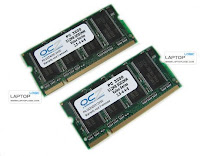 RAM:Random-Access Memory. Hardware inside your computer that stores information while you work. RAM is one of the things that makes your computer run faster. RAM is not permanent storage of data. When you turn your computer off, all data in RAM is lost. RAM is available in different types, sizes, and speeds. Currently, depending on the Motherboard, the Intel Celeron D CPU uses PC-2700 ram with 533 MHz FSB (Front Side Bus). The Intel Pentim 4 HT CPU uses PC-3200 DDR (double data rate) ram with 800 MHz Front Side Bus.
RAM:Random-Access Memory. Hardware inside your computer that stores information while you work. RAM is one of the things that makes your computer run faster. RAM is not permanent storage of data. When you turn your computer off, all data in RAM is lost. RAM is available in different types, sizes, and speeds. Currently, depending on the Motherboard, the Intel Celeron D CPU uses PC-2700 ram with 533 MHz FSB (Front Side Bus). The Intel Pentim 4 HT CPU uses PC-3200 DDR (double data rate) ram with 800 MHz Front Side Bus.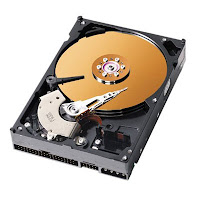 Hard Drive:A Data Storage medium that houses all of the information in your computer. This would include your operating system (Windows), device drivers, programs, and data you have created using your programs (word documents, spread sheets, etc.). Unlike RAM the Hard Drive retains data when the computer is turned off. Hard Drives sizes are in GigaBytes or billions of characters. EIDE hard drives spin at a speed of 7200 RPM. Older EIDE hard drives spin at 5400 RPM. New technology hard drives are now on the market, and these are SATA (Serial ATA) hard drives. Currently, these SATA hard drives have speeds approximately the same as EIDE. Looking ahead, the SATA hard drives will be faster and the prices will drop.
Hard Drive:A Data Storage medium that houses all of the information in your computer. This would include your operating system (Windows), device drivers, programs, and data you have created using your programs (word documents, spread sheets, etc.). Unlike RAM the Hard Drive retains data when the computer is turned off. Hard Drives sizes are in GigaBytes or billions of characters. EIDE hard drives spin at a speed of 7200 RPM. Older EIDE hard drives spin at 5400 RPM. New technology hard drives are now on the market, and these are SATA (Serial ATA) hard drives. Currently, these SATA hard drives have speeds approximately the same as EIDE. Looking ahead, the SATA hard drives will be faster and the prices will drop. 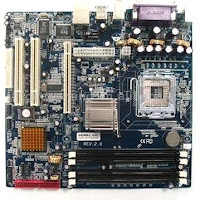 MotherBoard:The main circuit board of the computer. All key internal and external components of your computer plug into the MotherBoard, such as the CPU, RAM, Hard Drive, etc. The speed at which information travels across the MotherBoard is referred to as the BUS speed. Recently a new technology has been introduced called PCI Express. This allows a faster data transfer speed across the MotherBoard, especially for video graphics.
MotherBoard:The main circuit board of the computer. All key internal and external components of your computer plug into the MotherBoard, such as the CPU, RAM, Hard Drive, etc. The speed at which information travels across the MotherBoard is referred to as the BUS speed. Recently a new technology has been introduced called PCI Express. This allows a faster data transfer speed across the MotherBoard, especially for video graphics.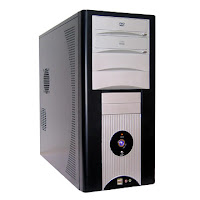 Case:small space where it can't breathe. Heat is the enemy of all computers. Often called the "computer", the case houses and provides power to the major computer components, including the MotherBoard, CPU, Hard Drive, RAM, Video Card, Sound Card, etc. Those components not housed in the computer case are usually referred to as "peripherals". The case also houses the power supply. It is important to have a large enough power supply to handle your current and future needs. Also important is that the case be large enough and have enough ball bearing fans so the internal components do not overheat and cause damage to themselves. Miniature cases are to be avoided. Never put your computer in a desk compartment or other
Case:small space where it can't breathe. Heat is the enemy of all computers. Often called the "computer", the case houses and provides power to the major computer components, including the MotherBoard, CPU, Hard Drive, RAM, Video Card, Sound Card, etc. Those components not housed in the computer case are usually referred to as "peripherals". The case also houses the power supply. It is important to have a large enough power supply to handle your current and future needs. Also important is that the case be large enough and have enough ball bearing fans so the internal components do not overheat and cause damage to themselves. Miniature cases are to be avoided. Never put your computer in a desk compartment or other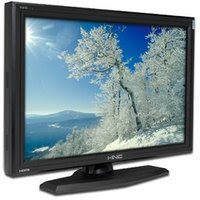
Monitor:The video display unit that sits on your desktop and serves as your computer screen. Monitors are available in two basic types. The CRT (cathode ray tube - looks like a TV set), called "flat" or "perfect flat" and the LCD (liquid crystal display) called "flat panel"- pictured on the left. The LCD Flat Panel monitors are more expensive, but have a smaller footprint on your desktop. The better LCD monitors can support digital (better) or analog input from the video card. With LCD Monitors we must watch closely the "response time". This is how fast the monitor redraws the picture. If you get a LCD with a slow refresh rate, some video or games may be jerky to watch.Be careful when you buy - rebuilt or refurbished monitors may be called "new" and have a one year warranty. You want a "brand new" monitor with a three year warranty.
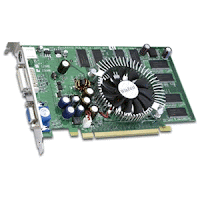 Video Card:A circuit board that plugs into a MotherBoard slot, usually an AGP (accelerated graphics port) slot or PCI Express slot (newer/faster/more bandwidth) and handles multimedia applications and graphics-intensive web sites freeing up the CPU (thereby increasing your computers speed). The monitor plugs into the video card which is accessed thru a slot in the back of your computer. The better the graphics chip on the video card, and the more ram built on the video card, the faster the display on the monitor. Top of the line games need very high performance video cards. Better Video Cards have both Digital (better) and Analog outputs.
Video Card:A circuit board that plugs into a MotherBoard slot, usually an AGP (accelerated graphics port) slot or PCI Express slot (newer/faster/more bandwidth) and handles multimedia applications and graphics-intensive web sites freeing up the CPU (thereby increasing your computers speed). The monitor plugs into the video card which is accessed thru a slot in the back of your computer. The better the graphics chip on the video card, and the more ram built on the video card, the faster the display on the monitor. Top of the line games need very high performance video cards. Better Video Cards have both Digital (better) and Analog outputs.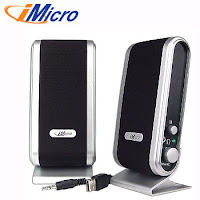
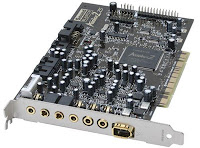
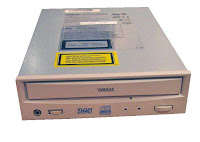 CD-ROM:Compact Disk - Read Only Memory. An optical storage technology that stores and plays back data. "Read Only" means the information can be displayed and used or copied, but cannot be deleted or changed (on the disk). One CD-ROM can hold around 650 megabytes of data, or the equivalent of 450 floppies. The speed of a CD-ROM refers to how fast the disk spins in the device.
CD-ROM:Compact Disk - Read Only Memory. An optical storage technology that stores and plays back data. "Read Only" means the information can be displayed and used or copied, but cannot be deleted or changed (on the disk). One CD-ROM can hold around 650 megabytes of data, or the equivalent of 450 floppies. The speed of a CD-ROM refers to how fast the disk spins in the device.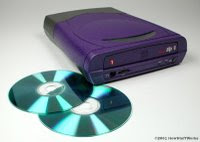 CD-Burner or DVD/CD Burner :A CD Burner is the informal name for a CD recorder, a device that can record data to a compact disc. CD-Recordable (CD-R) and CD-Rewritable (CD-RW) are the two most common types of drives that can write CD's, either once (in the case of the CD-R) or repeatedly (in the case of the CD-RW). In the CD-R recording process, the data is actually etched into the disc (burned) with a laser. In the CD-RW process the disk must first be formatted (burned) and then data is copied to or erased from the CD-RW media. Almost all burners can do both tasks - record (CD-R) and rewrite (CD-RW). The best way to determine this is from the specs. "52x32x52a" would be a spec for a current burner. The 52x means the record speed (CD-R), the 32x means the rewrite speed (CD-RW) and the 52a (a = average) means the read speed. If you have a CD-Burner, then a separate CD-ROM is not necessary.The DVD Burners read, write, and re-write to DVD,s and read, write, and re-write to CD's. If you have a DVD Burner, then a separate CD-Burner is not necessary.
CD-Burner or DVD/CD Burner :A CD Burner is the informal name for a CD recorder, a device that can record data to a compact disc. CD-Recordable (CD-R) and CD-Rewritable (CD-RW) are the two most common types of drives that can write CD's, either once (in the case of the CD-R) or repeatedly (in the case of the CD-RW). In the CD-R recording process, the data is actually etched into the disc (burned) with a laser. In the CD-RW process the disk must first be formatted (burned) and then data is copied to or erased from the CD-RW media. Almost all burners can do both tasks - record (CD-R) and rewrite (CD-RW). The best way to determine this is from the specs. "52x32x52a" would be a spec for a current burner. The 52x means the record speed (CD-R), the 32x means the rewrite speed (CD-RW) and the 52a (a = average) means the read speed. If you have a CD-Burner, then a separate CD-ROM is not necessary.The DVD Burners read, write, and re-write to DVD,s and read, write, and re-write to CD's. If you have a DVD Burner, then a separate CD-Burner is not necessary.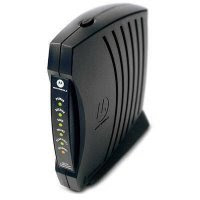
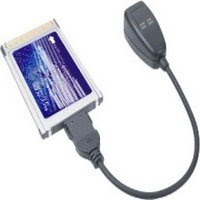 Ethernet Card:A circuit board that plugs into your MotherBoard and provides the capability to connect or "Network" your computer to other computers and/or the Internet. If you use a cable modem, your computer will need an Ethernet card. Ethernet cards come in different speeds. A 10 Mbps card can transmit/receive at 10 million bits (8 bits to a byte) per second. A 10/100/1000 Mbps card can transmit/receive at up to 1000 million bits per second.
Ethernet Card:A circuit board that plugs into your MotherBoard and provides the capability to connect or "Network" your computer to other computers and/or the Internet. If you use a cable modem, your computer will need an Ethernet card. Ethernet cards come in different speeds. A 10 Mbps card can transmit/receive at 10 million bits (8 bits to a byte) per second. A 10/100/1000 Mbps card can transmit/receive at up to 1000 million bits per second.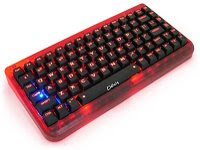
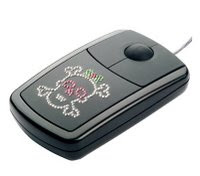 Mouse:A peripheral device connected to your computer, used to reposition the cursor or move the pointer on your screen. A mouse usually has at least two buttons, you can use to highlight text, open menu items, launch programs, etc. A mouse can be corded or wireless. Some mice have a ball on the bottom that rolls as you push the mouse, and some mice have optical function. No ball, the mouse senses the movement by an optical beam it emits. There is no need for a mousepad with an optical mouse.
Mouse:A peripheral device connected to your computer, used to reposition the cursor or move the pointer on your screen. A mouse usually has at least two buttons, you can use to highlight text, open menu items, launch programs, etc. A mouse can be corded or wireless. Some mice have a ball on the bottom that rolls as you push the mouse, and some mice have optical function. No ball, the mouse senses the movement by an optical beam it emits. There is no need for a mousepad with an optical mouse. 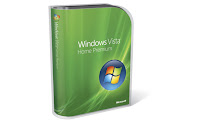 applications and computer peripherals. It schedules tasks, allocates storage, handles the interface to peripheral hardware and presents a "default" interface to the user when no application program is running.
applications and computer peripherals. It schedules tasks, allocates storage, handles the interface to peripheral hardware and presents a "default" interface to the user when no application program is running.Posted by eYKa at 5:46 PM 0 comments

